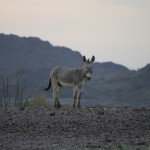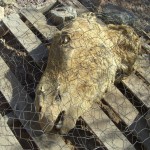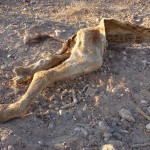Some RVers who volunteer at National Wildlife Refuges never return to the same refuge twice. Others, however, return to the refuges they enjoy year after year. We fall into the second category. This season, I am anxious to inspect the condition of the burro skull we left to the maggots last spring.
After spending the summer in Jackson, Wyoming, we’ve returned to Imperial National Wildlife Refuge 40 miles north of Yuma, Arizona. It’s like returning home, a place where we feel welcomed and comfortable – just as it is when we summer at the National Elk Refuge near Grand Teton National Park.
Burro Carcass
Before we departed Imperial at the end of March, 2009, a vehicle hit a burro on Martinez Lake Road, leaving the carcass on the side of the road. We drove to the site several times over the next two days and sat in the car watching vultures peck away at the most tender parts of this burro jack’s (male) body.

“I would love to have that skull,” I said. Because of limited space in an RV, I wouldn’t add it to my skull collection, but instead leave it at the visitor center. But I’d already been told that burros are protected and cannot be disturbed. “What a waste!”
After a couple days of wishing, I called Bureau of Land Management to ask if there was some way we could legally obtain the skull. “Just go get it,” the voice on the other end said.
“I thought burros are protected.”
“They are when they’re alive. But when they die, they lose their status.”
Retrieving the Carcass
Within minutes, we were driving the Refuge Suburban down the road, following two maintenance workers who agreed to break away to help us disengage the head from the rest of the anatomy. Although the drive was no more than six or eight miles, it seemed we’d never arrive. I felt like Indiana Jones anxiously awaiting the opening of the Well of Souls. What if the body parts had already been raided?
Finally we parked and approached the dead burro. The putrid odor of rotting flesh permeated the air, and we could have located the carcass merely by the stench. Fetid as it was, however, it was still intact. It might have even been mistaken for a fresh kill except for the large hole near the anal area pecked through soft tissue by vultures, as well as an empty eye socket and a missing ear.
Despite the eye-watering stink, the maintenance workers set to work with a crosscut saw. While one secured the head with his foot, the other raked the saw back and forth across the neck between two vertebrae. With each stroke, blood oozed from the new wounds and spurted from the empty eye socket like a tiny fountain. Because the saw was not adequate for this purpose, the job took longer than expected. But finally the last threads of ligaments, tendons, muscle, and flesh broke free.
Securing the Head
Chuck wrapped the head in a large plastic garbage bag and heaved it into the back of the Suburban. “This thing must weigh 50 pounds!” Indeed, the skull alone would be substantial, but the added weight of muscle, skin, and brain increased the burden.

Once back at the Refuge, we unloaded the head onto a pallet far from the maintenance shop and other areas of activity to avoid inflicting the smelly body part on workers and other volunteers. “We’ve got to secure it so nothing drags it away,” I said, even as Chuck left to locate some chicken wire. Burying the head did not seem to be an option in this climate. The maggots would do their work well enough above ground, we felt, and we feared a coyote might unearth our trophy and drag it away for its own dinner.
When Chuck returned with the wire, he laid it over the head and staked it down with heavy rocks, all the while periodically turning his own head into the wind to inhale a bit of fresh air. Flies that couldn’t wait until we finished swarmed about us with the excitement of a cloud of gnats on a sweaty face. Swatting away persistent insects, we stood back to examine our work and decided it was good enough. We’d had enough putrid, brain-numbing odor and invasive pests for the day. We would check the skull when we returned in the fall.
Upon Return
And now it’s fall, and we have returned. For the first few days, we were too busy settling in to bother with extraneous activities. On our way to and from town, we’d seen the remains of the rest of the carcass — two legs and part of the back — still laying at the side of the road.

But today we finally stopped by the staked-out skull to check the results of roasting under the broiling Sonoran Desert sun all summer while infested with voracious parasites. We hoped to see a dazzling ivory skull. Instead, fuzzy skin still covered the head and the skull still looked like….well….a burro. Even its lips, though pale and rigid, still covered the teeth.
Upon closer examination, however, we could see that the muscle had decomposed and that the skin had shrunk, plastering it to the bone, giving the head the appearance of a mummified burro. When poked with a snake hook, the skin tore like parchment paper.
Someday soon we’ll lug it up to our campsite and attempt to peel away the rest of the skin. For now, we are satisfied knowing that our treasure was not hauled away while we were away.

Can’t you do what we did in science class many (many, many) years ago – boil it? Or does that leach too much out of the boney structure?
There’s so many ways to prepare a skull by the amateur, and most of them do more damage than good. A lot of procedures make the bones more brittle. We may send it to a taxidermist in MT for a professional (and costly) job. First however, we will check with the folks at AZ Game and Fish for their ideas. Thanks for the nice comments on the YNP wolves!